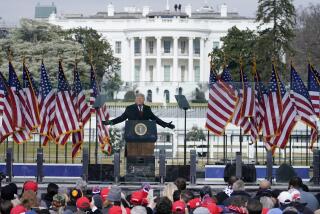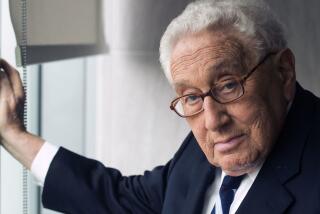Timothy Naftali: Nixon’s checker
Timothy Naftali is the kind of learned guy you’d want on your team when you play “Trivial Pursuit” -- a game that, like Naftali, originated in Canada. But for years, his home and his career have been in and about the United States -- books and studies on espionage, counter-terrorism, the Cuban missile crisis, U.S. intelligence. And now he is director of the Richard Nixon Presidential Library. That would be the new Nixon library, the one operated under the auspices of the National Archives. The old, private Nixon library’s spin on the president, especially about the Watergate episode, prompted the feds to refuse to transfer control of tapes and documents -- until Naftali and the National Archives took over to make the library a nonpartisan scholarly and educational resource. The post he accepted five years ago requires some of the same diplomatic and historical skills he’s studied, and others. The exhibit that must demonstrate all of this transparency opened this week -- the Watergate gallery, symbolized by what Naftali’s holding, one of the Watergate wiretapping “bugs.”
I expect everyone wants to know how Richard Nixon figured in your life before you were recruited for this job.
Nixon does not play a major role in my life. [But] you couldn’t live in a country [Canada] allied with the United States, young as I was, without knowing who he was. I remember his resignation speech. We were staying with friends of my parents who happened to be named Nixon. I kid you not.
In part because of Nixon and détente, you visited the Soviet Union on a student tour as a young teenager.
It was a formative visit. They tried too hard to stuff us with propaganda. This is relevant to what I do now; how do you activate the gray cells of 12-, 13-, 14-year-olds in a public building? [The Soviets took] us to these meeting rooms [to] give us a lecture on Communism and capitalism. Besides being boring, it was offensive.
How did history interest you?
A couple of things shaped my thinking. You sit with a grandparent [who endured World War II] and listen to them talk about a world turned upside down. If somebody talks with you about the concentration camps and what it’s like to have your country go to war and because you’re a member of a certain religious minority [you’re put] in a [forced] labor camp -- my grandfather was in forced labor, and my grandfather’s brother died in Auschwitz -- you can’t hear these stories without [their] giving you a deep desire to know why. [And] you can’t live in the United States without being interested in presidents. The way we describe our governmental system is president-heavy. We have three branches and we sometimes forget about two of them.
You worked on the presidential tapes of JFK and LBJ through the University of Virginia’s Miller Center.
You think about the Kennedy tapes -- that would be a pool. The Johnson tapes are a lake. The Nixon tapes are an ocean. Richard Nixon left us 3,700 hours of tapes. John F. Kennedy left about 265 hours. I learned the presidency is almost an impossible job. No one can be trained to be president. I’m talking about the presidencies [that] have been caught like a fly in amber: Kennedy, Johnson, Nixon. We can listen to them think aloud, listen to them consider options, but more importantly we learn about time. Reading documents doesn’t tell you how much time is needed to make a decision and how many decisions they have to make at the same time. [With the tapes] you are there when the president has to deal with unemployment and a riot and a foreign challenge simultaneously. And this is the kicker -- they do it on the basis of imperfect information. They don’t know what they’re later going to know. [But] you know. You also know, this is going to be bad. It’s heartbreaking. You learn the presidency is a cacophony of choices and imperfect information.
George W. Bush’s will be only the 13th presidential library.
The presidential library system is Franklin Roosevelt’s gift to the United States. [Until then] presidents owned their papers -- they could dispose of them as they wished. A lot were destroyed or sold. Abraham Lincoln’s collection is all over the place. The deal was the federal government would run the library, the president would deed his papers to the people -- many of them took a tax deduction -- and the government would be responsible for preserving the materials and for overseeing their release. [Initially], presidents could set up all kinds of obstacles to release. Not anymore. That era ended with Watergate.
Then is there a higher threshold of credibility for the library now that it’s under the aegis of the National Archives?
President Nixon left arguably the finest collection of material of any president, because of the tapes, but also because of the way he managed. [We] have layers of paper as ideas wended their way up to the president. I knew how important the tapes were. I knew there was an antagonistic relationship between the [Nixon] Foundation of that era and the National Archives. I was asked to make the library a federal institution [that] would be absolutely nonpartisan. It’s essential -- given Watergate, given the special obligation Congress assigned to the National Archives in the wake of Watergate -- that the public who visit this museum and archive believe they are getting all the materials on abuse of government power to which they are entitled. I felt that if the museum whitewashed or soft-pedaled in any way the story of Watergate, how could a reasonable visitor believe [what is presented]?
How profound are the changes in the Watergate exhibit? I’ve read that before, visitors might be told the 181/2-minute gap on the critical Watergate tape was a mechanical malfunction, or that Watergate was a “coup’’ by Nixon enemies and that reporters Woodward and Bernstein were offered bribes for their stories.
I am eager for the public to judge how great a change there is. I can’t wait. I assure you that my mission was to lay out the facts regardless of how difficult or provocative they might seem. I made this clear from the beginning. I neither like Richard Nixon nor hate him. I must say I find him a compelling figure. I said “If you want [me to do this job], I’m going to lay out the facts.” People can [now] tell us if they agree.
The Watergate story is Dickensian -- the characters, the hush money, the Cuban Americans. I interviewed [as part of the oral history interviews] one of the Cuban burglars; he talks about breaking into the office of [Daniel Ellsberg’s psychiatrist]. I had long interviews with Ellsberg, John Dean, Robert Bork, George Schultz -- they’re all participants. For kids who don’t know who these people are, I wanted them to be able to push a button and hear G. Gordon Liddy talk about planning the break-in, Alexander Haig talking about Nixon.
The Richard Nixon Foundation, which still operates the bookstore and birthplace and which ran the museum as a private venture outside the National Archives until 2006, raises objections to elements of the new Watergate gallery. What’s the relationship with the foundation?
This is a time of healing. The Watergate exhibit will be difficult, but once we move past that, perhaps the relationship can improve. I’m optimistic because I was in Monticello when the basic narrative of the Thomas Jefferson Foundation changed with the DNA evidence of Sally Hemings. I witnessed the broadening of the narrative to reflect new information and new interpretations, and [we] are working really hard for that to happen [here].
What do you make of Nixon revisionism, when even Democrats now point out that he created the EPA, OSHA and other programs now regarded as liberal?
He does not permit easy explanation. Those who would say he’s just a conservative have to reckon with his relatively progressive domestic program. The environmental impact statement, the toughening of auto emissions standards, OSHA -- products of the Nixon administration. On the other hand, as visitors to the Watergate gallery will see, he was responsible for abuse of governmental power. His is a complex legacy. I’ve heard the argument that Richard Nixon did what every other president did, except he got caught. This exhibit leaves it up to you to determine how bad all of this was. I think it’s healthy for people to know that if their government abuses its power, there will be a reckoning, and that teaches future generations, “Don’t be cynical. We have a phenomenal Constitution. We have institutions that work. Learn about them so if you need their help, you can get it.” The worst thing we can have is ignorance. It’s a vacuum to be filled by those who would abuse power.
What have you learned about Nixon that’s surprised you?
My first really deep knowledge of President Nixon came from the tapes. You cannot understand Richard Nixon without delving into his personality. Many of the tapes are troubling. I’m not suggesting we have to be psycho-biographers, but it’s essential to understand the importance of personality.
Perhaps one of the hardest challenges [for the exhibits is capturing] the climate of that period. If you’re under a certain age, you will not understand what it was like -- emotional and at times strident demonstrations, a seemingly endless war in Vietnam, a feeling the government was lying, you don’t think your rights are being honored, and you may be drafted to die in a war you don’t understand and are not old enough to vote for. On the other hand, you have a leadership class [from the World War II era] that does not understand this resentment. And then you add a president with a complex personality, and the outcome was incendiary.
How does the funding work?
The federal government pays for the lights, the utilities, the staff. There’s no money from Congress for public programming or for exhibits. You get a museum, but if you want to change that museum, you raise the money yourself or go to the foundation for money. In 2007, when I invited [historian and Nixon critic] Elizabeth Drew to the library, the Nixon Foundation began shutting off funding for public programming and exhibits and by 2009 it had completely shut it off. Unlike other [presidential] libraries, I don’t get any money from the foundation.
Because they objected?
You’d have to ask them. I have a big-tent philosophy. When I started inviting people who were left of center and I think some centrists, I got enormous pushback. I kept doing it because it’s my job. What I did instead [was] raise money. We have been entrepreneurial and frugal.
What are some other big changes?
We replaced some panels that we found polemical or historically inaccurate. The only permanent gallery we’ve altered completely is the Watergate gallery. It’s expensive to update technology, and to do the entire museum will cost about $10 million. We’ll give [visitors] useful portals; you have the opportunity to experience iPad history.
This interview was edited and excerpted from a longer taped transcript. Interview archive: latimes.com/pattasks.
More to Read
A cure for the common opinion
Get thought-provoking perspectives with our weekly newsletter.
You may occasionally receive promotional content from the Los Angeles Times.







